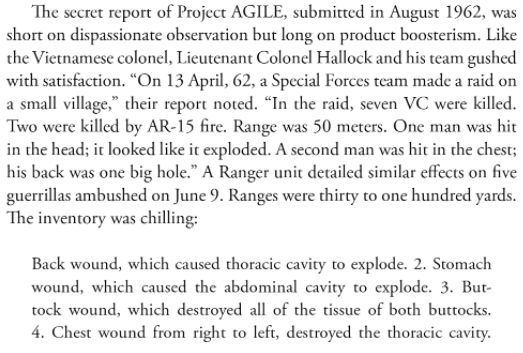Talk to a hunter and or a military veteran who has
Post# of 128927
It's about muzzle velocity, cavitation and the tendency of a lighter round to tumble or splinter upon entry of soft tissue.
The Simple Physics That Makes Some Bullets Deadlier Than Others
How higher speed, greater mass, and more surface area increase the damage that rounds can do to human bodies.
https://www.thetrace.org/2017/06/physics-dead...lt-rifles/
Developed in the early 1960s, the .223 round was first used in Vietnam. The U.S. military collected reports of its effects on the first Viet Cong combatants to be shot with the bullet. Here’s what they found it did to those enemies’ bodies, as republished in New York Times reporter C.J. Chivers’s history of the assault rifle, The Gun:

Surface area
In the macabre world of terminal ballistics, the study of what happens when projectiles actually strike, much can be made of over-penetration: the phenomenon of bullets passing clean through their targets. That’s a problem, because the force that continues to propel the bullet has essentially been wasted, not transferred to the target.
That problem is solved by making more of a bullet’s surface area actually come in contact with its target. Rifle rounds have an elongated, oblong shape and so they often tumble. When they strike, the bullets rotate, and more of their surface hits the body.
Bullets can also increase the surface area that transfers energy to targets by expanding, as in the case of hollow-point rounds. The wider bullet also creates a bigger cavity in whatever it passes through. “If a projectile has features that would cause it to expand upon impact,” U.S. Army engineers Donald Carlucci and Sidney Jacobson explained in the textbook Ballistics: Theory and Design of Guns and Ammunition, “it will cause greater trauma.”
Hollow points also create a larger temporary cavity. The temporary cavity is the hole in the target that briefly expands after immediate impact, only to collapse a fraction of a second later. While the tissue affected by the temporary cavity isn’t completely destroyed like that in the direct path of the bullet, it does suffer trauma, especially if the bullet travels past less-flexible parts of the body, like bone or dense organs like the liver, which can shatter or rupture from the shockwave.
In one case study of a 24-year-old man struck in the chest by a .40-caliber hollow-point pistol round, doctors found organ damage outside the direct path of the bullet. Though the patient survived and only had a small wound, he suffered extensive contusions throughout his lungs.
Dr. Leana Wen, a trauma surgeon and the health commissioner for Baltimore, wrote a column in the New York Times about the especially devastating effects of expanding rounds: “often pulverizing bones, tearing blood vessels and liquefying organs.” She remembered one young man who was admitted to her emergency room with an abdominal wound from a hollow-point round.
“Blood poured out of his chest cavity,” she wrote. “The bullet had disintegrated his spleen and torn his aorta. Four ribs had essentially turned to dust. The damage was far too extensive. He died in our E.R. He was 15.”
Ballistics engineers try to balance speed, mass, and surface area to make the most effective round possible. At The Trace, we examine what happens after bullets are sold, shot, and wound human beings. The damage is often extensive, and not just for those who die.
Shooting survivors and their caregivers describe a lifetime of chronic pain, repeated surgeries years after being shot, and challenges to everyday living that come from losing parts of vital organs, like a woman who has to buy her son expensive protein shakes after he lost much of his stomach.
We are currently looking for shooting survivors to discuss their experience and their recovery. If you have been hit with any kind of bullet — large, fast, expanding, or otherwise — please fill out our survey about your experience after being shot.
 (0)
(0) (0)
(0)